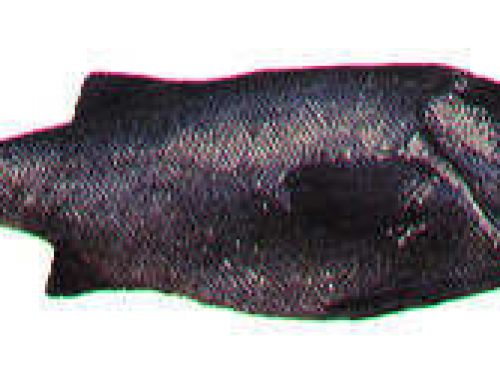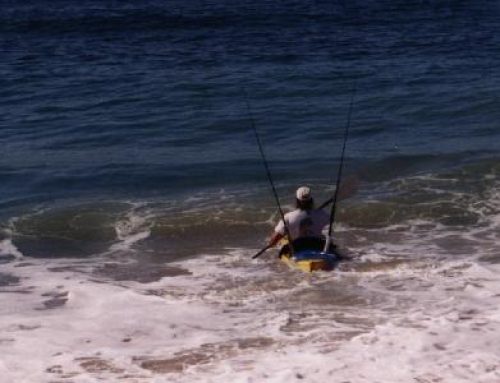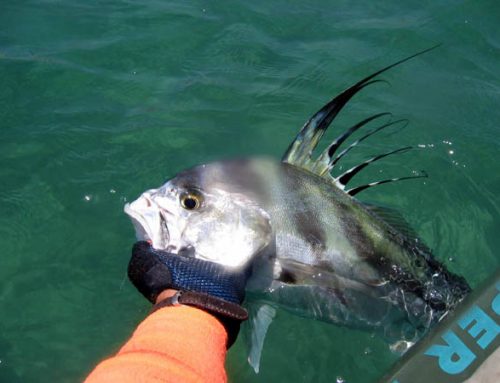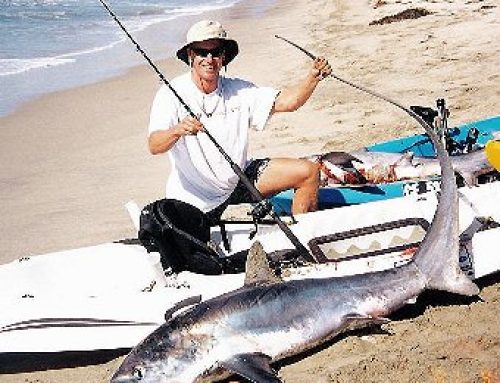GEARING UP
Short of a kayak and necessary paddling gear, most anglers getting into kayak fishing already have most everything they’ll need. Fishing kayaks range from simple craft to extreme sport fishers. (PHOTO) The majority of models are rotationally molded plastic sit-on-top designs but traditional sit-in kayaks are seen in cold water and high mileage fisheries. Composite fishing kayaks are an upgrade in product quality on many levels, often with traditional touring kayak design. Composite fishing kayaks are constructed differently and more expensive than roto-boats, need to be handled with care and don’t take a beating like better quality thick polyethylene. Proven fishy and considered “performance” fishing kayaks for speed and weight, composite fishing kayaks continue to increase in quality and popularity!
Kayaks New and Used– Popular fishing kayaks often come off the sales floor with stuff intended for fisheries located far from the point of sale. Like anchor riggings for skinny water, beam (kayak width) for standing and special features over regional fishability. Few kayaks come with a few things that we really do need BLV. Nearly every popular model of fishing kayak in North America comes available on Craigslist and the classified ads of regional forum based kayak fishing websites. Like scuba, surfing and other outdoor pursuits, people buy this stuff, use it once or twice and sell it a year later. Often with a lot of gear and accessories.
Basic Paddling Gear and Fishing Accessories–
Basic needs include:
Kayak (that fits you AND the fishery),
Paddle (that fits you and the boat) 2 piece breakdown paddle with left and right control is recommended. Saltwater anglers, break down your paddle after every use for longer life.
Lifejacket-a comfortable PFD,
Backrest/seat,
Landing net-required in California and other States.
Dry Bag
Bowline
Handheld VHF Radio-Starting under $100 bucks…CHEAP SAFETY GEAR, be thankful the USCG has such big ears! Most radios work from a cheap clear plastic case.
2 Flush mount rod holders, mounted behind the seat. Additional rod holder styles and placements vary from model to model. Some kayaks, and some anglers, are better suited with a porcupine of rod holders and placements on the aft deck utilizing a milk crate, bucket or bag type rod holders. Forward rod holders are great for some trolling, deadsticking and rod/net/gaff/light stick and that kind of storage. Commercially sold aft deck kayak rod holder/gear stations were on the market with kayak fishing specialty retailers the last time we looked. “Grow into your gear, one outing at a time, has served a lot of kayak anglers.”
Garments and Footwear
Consider neoprene booties with a hard sole or a good water shoe for foot protection and the appropriate paddling garment(s) for the water temps and shoreline conditions you’ll fish.
Surfsuits with 3/4mm or 4mm thickness, farmer john or jane style, cost about $135 providing comfort protection, easy care and years of service. In coastal fisheries, neoprene is often peeled down to the waist OTW with dry fluffy layer on top. Paddling garments, not safety suits, dry pants start around $150 and paddle jackets range from $65 to well over $200. One-piece drysuits are great garments, a best choice (even if you only wear it a few times a year) and cost more than a lot of people spend on their kayaks.
Concerned about a big outlay? We recommend holding off on a fishfinder*, expensive seating options, hundreds of dollars in mounts and rod holders from various outfitters for various models and an expensive wheel cart. Foam racks are cheap and won’t damage your car. New roof racks from the popular brands can run $800.00+ and look really good on your vehicle. Less expensive options exist. Farmer John/Jane surfsuits start around $135 and most everything needed can be found in great used condition if you know what to look for. The whole point is that anybody can start kayak fishing at a modest cost and grow into their gear or make a dedicated investment and achieve the same results.
* FISHFINDERS -Guiding the Coastal Kayak Fishing School, an entry level session for anglers new to kayak fishing, we see 2 motivations. Anglers who recognize the value in the class before gearing up and anglers who purchased everything they could think of and spend a season ruining and losing gear with marginal fishing results. The majority of those anglers never leave the forward seated position and they watch their sonar like it’s a fishfinder (it’s really a structure locater first and foremost). We guide anglers to develop their eyes and ears on the water before getting “glued to the TV”.
Pack a dry bag with water, clothing and sunscreen plus safety gear including a phone and VHF radio. Choose one rod, a waterproof box for tackle and a landing net and it’s time to plan the maiden voyage.
Urinating is an issue for some and a more serious consideration for some freshwater bodies. A plastic urinal with a lid is a great way to go. In coastal waters, peeing towards a footwell scupper hole with a quick rinse is more accurate than “over the side” and easier for girls. Different kayak models allow for better or worse peeing posturing, that’s a fact. Just another consideration for “getting a feel for your kayak” but frankly, trained balance negates these concerns.
We recommend everyone grow into their gear within a span of several outings, months and even years. Some anglers go the other way and instal every rod holder, gizmo and contraption they think they need before the maiden voyage and we understand that. Figure out what kind of rod holders you want (2 flush mounts generally go behind the cockpit) and where you want them. Portable or permanant fishfinder? Integrated or handheld GPS? What about a live bait tank? Storage needs. Most will need a wetsuit or dry wear, paddle wear or just fish in a Speedo? Please advise prior to launch on the latter :). Quality gear for all your needs, at every price point, is essential and available.





